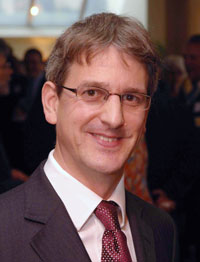Books & Arts

“I FEEL like Dorothy in ‘The Wizard of Oz’; picked up by a whirlwind and dropped down in a land where everything is much more brightly coloured,” says Thomas Campbell, who on January 1st became the new director and CEO of New York’s Metropolitan Museum of Art. His description is both apt and unexpected.
“我感觉像《绿野仙踪》里的桃乐茜;被一阵旋风刮起,然后在一个地方掉了下来,那里一切都是色彩斑斓,”托马斯•坎贝尔的描述恰如其分,也令人出乎意外。元月一日他成为了纽约大都会艺术博物馆的新任管理人和行政总裁。
Until five months ago, the British-born 46-year-old, educated at Oxford University and London’s Courtauld Institute of Art, was by his own account, “an open shirt, tweed jacket sort of guy”. He liked to clear his diary to give time to his research and writing. Now he owns several new suits and has a crammed schedule. The studies to which he has devoted the past 20 years have had to become a hobby, like the watercolours he paints. The Campbells have moved from the suburbs to a flat near the Fifth Avenue museum. It comes with what many consider the international museum world’s top job.
Cinderella also comes to mind when considering the events of the past year. During the search for a successor to Philippe de Montebello, the French-born director who was retiring after 31 years as head of the museum, Mr Campbell, a British tapestry specialist, never featured on the gossips’ shortlist, although all but two of the museum’s directors in the last century have been recruited from within. Mr Campbell joined the Met in 1995, but he has never headed a department and was only one of its ten curators in European sculpture and decorative arts.
What the gossips overlooked—but the search committee did not—are the two exceptional exhibitions of Renaissance and Baroque tapestries that he organised in 2002 and 2007. A surprise hit with both public and critics, the shows demonstrated Mr Campbell’s considerable scholarly, diplomatic and administrative skills. In addition, supervising the museum’s Antonio Ratti Textile Centre introduced him to curators from almost every department and increased his knowledge of the museum’s immense holdings, which number more than 2m objects.
Thinking about his new role and all those treasures, Mr Campbell smiles and says, “I feel like a kid in a candy store.” This is probably not a phrase the aristocratic Mr de Montebello would have uttered. Superficially, he and the boyish Mr Campbell could not be more different. Yet superficial is what their differences appear to be.
Mr de Montebello has been characterised as a connoisseur; a curator’s director. He says that the choice of Mr Campbell as his successor “sends out a clear message that scholarship is more important than marketing”. Mr Campbell is proud that, as he takes over, the Met has exhibitions on Babylonian trade routes, the Italian Renaissance, African textiles and 17th-century Chinese watercolours, all planned by his predecessor.
Both men prize scholarship, a global outlook and outreach, while keeping a respectful eye on the bottom line. Mr Campbell has inherited a well run, financially sound institution. Emily Rafferty, its president, is a gifted fund-raiser. The museum’s last annual report values the endowment at $2.5 billion. Mr Campbell believes that the great encyclopedic museum he heads can be “a place of inspiration, almost of refuge and hope” in a difficult economic climate, but cuts will have to come. Some will not be unwelcome. In Mr Campbell’s view fewer expensive loan shows will free up financial and creative resources for innovative displays of works from the permanent collection.
Some changes will not be money-saving. Not only does the new director intend to put the entire museum collection online, but he is also eager to use the internet more inventively to “tell the great stories of the objects we own and give visitors a sense of their artistry.” Mr Campbell buzzes with ideas about how this might be done. “It is a world of opportunities,” he acknowledges but adds quickly, “the challenge is delivering quality content.” For all his boyish appearance and references to “The Wizard of Oz”, Mr Campbell speaks with conviction and determination. There is no doubting his maturity, as well as his enthusiasm and his passion, when he talks about his feeling for art and his sense of responsibility to the institution he leads as well as to its millions of visitors.











